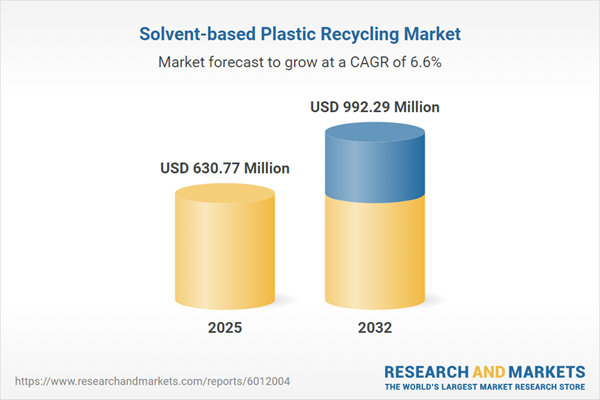Speak directly to the analyst to clarify any post sales queries you may have.
Solvent-based plastic recycling is redefining polymer recovery for value-focused industries, enabling closed-loop strategies while supporting regulatory compliance and circular economy goals. Senior decision-makers seeking actionable insights into advanced recycling and supply chain adaptation will benefit from this market-centric research.
Market Snapshot: Solvent-Based Plastic Recycling Market Overview
The Solvent-based Plastic Recycling Market grew from USD 593.44 million in 2024 to USD 630.77 million in 2025. It is expected to continue growing at a CAGR of 6.63%, reaching USD 992.29 million by 2032. Robust adoption is driven by the growing regulatory focus on advanced recycling, brand owner commitments to recycled content, and evolving trade policies. The market is seeing substantial technology investment, partnerships across the value chain, and increasing demand across packaging, automotive, and textile sectors.
Scope & Segmentation
This comprehensive report delivers in-depth coverage and strategic segmentation across all stages of solvent-based plastic recycling:
- Polymer Types: Polyethylene, Polyethylene Terephthalate, Polypropylene, Polystyrene, Polyvinyl Chloride
- Feedstock Sources: Post-consumer food containers, household packaging, multilayer films, textiles and fibres, and post-industrial process residues
- Technologies: Dissolution precipitation, solvent extraction dewaxing
- End-Use Industries: Automotive, building and construction, consumer electronics, healthcare, industrial goods, packaging, textiles
- Regional Breakdown: Americas (including United States, Canada, Mexico, Brazil, Argentina, Chile, Colombia, Peru), Europe (United Kingdom, Germany, France, Russia, Italy, Spain, Netherlands, Sweden, Poland, Switzerland), Middle East (United Arab Emirates, Saudi Arabia, Qatar, Turkey, Israel), Africa (South Africa, Nigeria, Egypt, Kenya), and Asia-Pacific (China, India, Japan, Australia, South Korea, Indonesia, Thailand, Malaysia, Singapore, Taiwan)
- Company Benchmarking: Alpla Werke Alwin Lehner, Borealis, Cleanaway Waste Management, Loop Industries, LyondellBasell, Mura Technology, PureCycle Technologies, Solvay, Trinseo, Viva Energy, and others
Key Takeaways for Decision-Makers
- Solvent-based recycling enables recovery of high-purity polymers from challenging streams, positioning it above conventional mechanical approaches for demanding industrial use.
- Growing global adoption is linked to stricter regulations, brand sustainability mandates, and enhanced collaboration across technology, chemical, and waste management firms for knowledge transfer and risk management.
- Feedstock diversity and process innovation allow this technology to address multilayer films and post-industrial residues, expanding access to non-traditional and previously underutilized polymer sources.
- End-use industries—particularly packaging, textiles, and automotive—leverage these recycled materials to achieve sustainability targets and maintain stringent quality standards.
- Digital tracking and certification are supporting full transparency in the supply chain, essential for compliance with recycled content standards and for building brand trust.
- Strategic alliances and R&D investments are focused on lowering energy consumption, enhancing solvent recovery, and expanding modular deployment to address evolving operational needs.
Tariff Impact: Navigating US Trade Measures in Solvent-Based Plastic Recycling
New US tariffs impacting polymer imports and intermediates from 2025 are recalibrating supply chains, with domestic recyclers accelerating investments to protect margins and access alternative feedstock streams. Transitional policies—such as tariff rate quotas and certification carve-outs—support market flexibility and sustainability compliance. These shifts are prompting accelerated adoption of solvent-based recycling to help organizations maintain resilience in cost structures and supply reliability.
Methodology & Data Sources
This report leverages structured interviews with technology leaders, supply chain experts, and regulators, alongside a rigorous secondary review of industry publications and policy documents. First-hand site visits and operational data analysis have validated key performance metrics, while process modelling and qualitative trend evaluation underpin the reliability of these findings.
Why This Report Matters
- Provides strategic clarity on market opportunities and technology adoption pathways for solvent-based plastic recycling.
- Equips leadership teams with actionable recommendations to navigate regulatory changes and emerging supply chain trends.
- Enables benchmarking against leading players, supporting competitive differentiation and value creation in a fast-evolving landscape.
Conclusion
Solvent-based plastic recycling is emerging as a foundational pillar for circular value chains and resilient supply strategies. This report delivers the critical market, policy, and technology insights required for informed, future-focused investment decisions.
Additional Product Information:
- Purchase of this report includes 1 year online access with quarterly updates.
- This report can be updated on request. Please contact our Customer Experience team using the Ask a Question widget on our website.
Table of Contents
3. Executive Summary
4. Market Overview
7. Cumulative Impact of Artificial Intelligence 2025
Companies Mentioned
The companies profiled in this Solvent-based Plastic Recycling market report include:- Alpla Werke Alwin Lehner GmbH & Co KG.
- Borealis AG
- Cleanaway Waste Management Limited.
- COL&BRI PARTNERS, S.L.
- CreaCycle GmbH
- Eastman Chemical Company
- Fraunhofer-UMSICHT
- KW Plastics
- Loop Industries
- LyondellBasell Industries N.V.
- Mura Technology
- PureCycle Technologies, Inc.
- RE&UP Technologies Holding B.V.
- ReSolved Technologies BV
- Saperatec GmbH
- Solvay S.A.
- Sulzer Ltd
- Trinseo PLC
- Viva Energy
Table Information
| Report Attribute | Details |
|---|---|
| No. of Pages | 189 |
| Published | November 2025 |
| Forecast Period | 2025 - 2032 |
| Estimated Market Value ( USD | $ 630.77 Million |
| Forecasted Market Value ( USD | $ 992.29 Million |
| Compound Annual Growth Rate | 6.6% |
| Regions Covered | Global |
| No. of Companies Mentioned | 20 |









